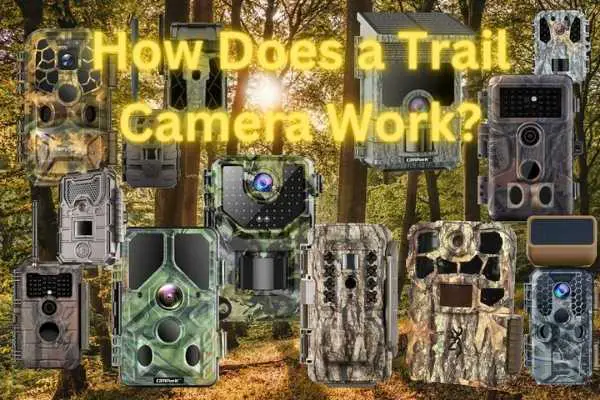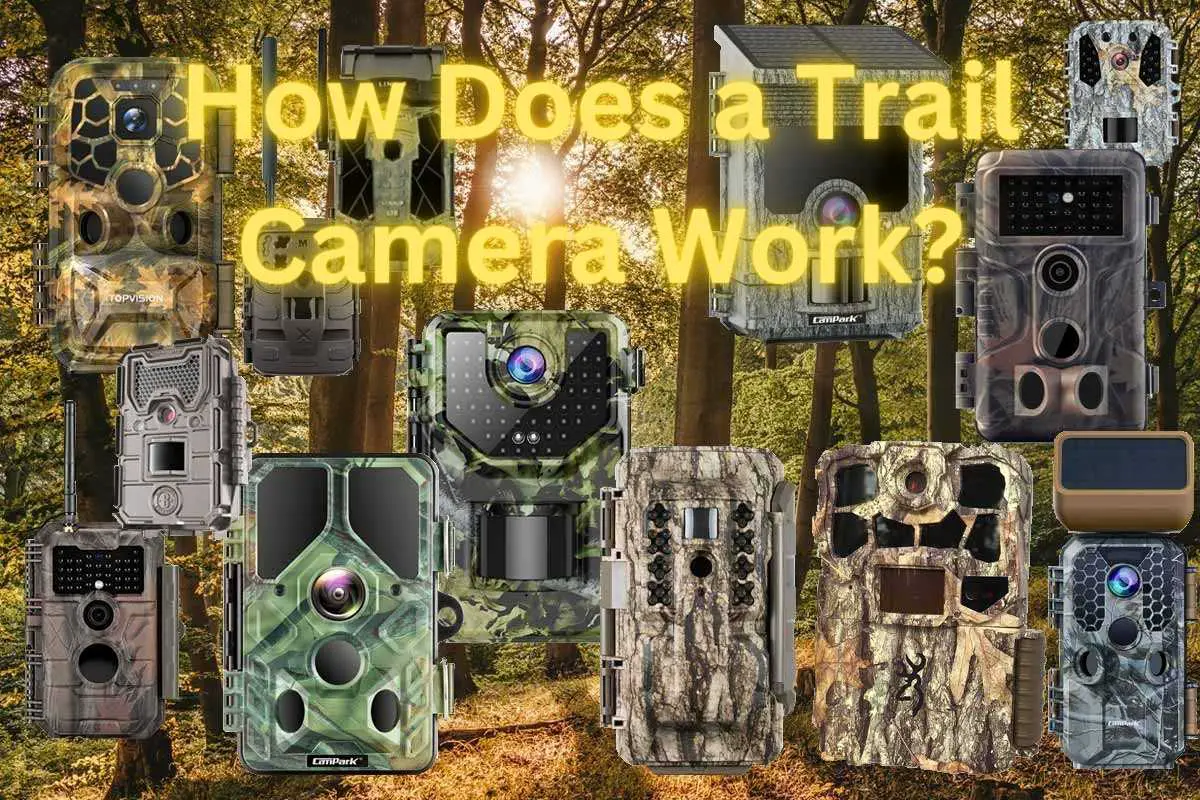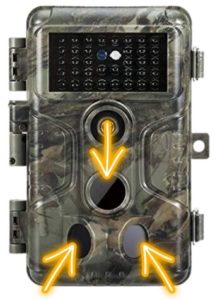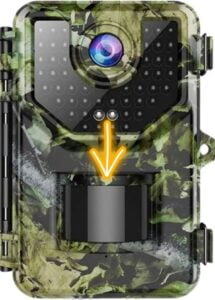Trail cameras are a type of camera that is frequently used by hunters, wildlife enthusiasts, and property owners. These cameras are designed to be left unattended for long periods of time as they take photos or videos of the animals or people that moved in front of it.
But how do trail cameras work? In this article, we’ll answer that question and explore everything you need to know about these amazing devices.
Table of Contents
What Is a Trail Camera Used For?
The most common use for trail cameras is to monitor game animals or other wildlife in an area. They are usually mounted on trees or posts in strategic locations, such as near a water source or along a game trail, in order to get the best possible pictures or videos of wildlife. Trail cameras are a valuable tool for hunters, as they can help to pattern the behavior of game animals.
The second most common use for trail cameras is for security and surveillance purposes on both personal and commercial properties. Some people who are using trail cameras for security and surveillance purposes might opt for a camera with cellular connectivity depending on how quickly they want to see the pictures and videos it has captured.
How Do Trail Cameras Work?
Trail cameras differ from regular cameras in that they can sense when a subject is in front of them so they know when to take a picture or record a video. However, unlike security cameras that need to remain tethered to an external power source or connected to the internet, trail cameras can be placed almost anywhere on a property, which makes them much more versatile.
So how do trail cameras do this?
Let’s break it down by examining their main systems or components.
What Is the Power Source for Trail Cameras?
Trail cameras are powered by batteries, typically 4 or 8 AA batteries. They can be disposable (alkaline or lithium), and depending on the model some cameras can even use rechargeable batteries. Lithium batteries are regarded as the best batteries for trail cameras as they can provide consistent voltage throughout their life cycle
Many models will have an external power input, which allows you to connect an external power source, such as an external battery or solar panel. Using an external power supply can drastically increase the amount of time you can leave the camera unattended without having to worry about it running out of power.
How Do Trail Cameras Detect Activity in Front of the Camera?
Have you ever wondered how your trail camera knows when to take a photo? It’s all thanks to the detection circuit, which depending on the camera, includes 1 or 3 PIR sensors.
PIR sensors, also known as passive infrared sensors, work by detecting changes in infrared radiation that is emitted by all objects that have a temperature above absolute zero (-273 degrees Celsius). The amount of infrared radiation emitted by an object depends on its temperature with warmer objects emitting more infrared radiation.
PIR sensors are used in trail cameras to detect the movement of heat-producing objects, such as animals, people, or vehicles. The sensor consists of a pyroelectric element that generates an electric charge when exposed to infrared radiation. When a rapid change in infrared radiation that is the result of a moving object in front of the sensor is detected, the charge on the element changes, and this change is used to trigger the camera to take a picture or record a video.
There are a few things to keep in mind when it comes to PIR sensors and trail cameras. First, the detection area of the sensor can vary, depending on the make and model of the camera. Second, the sensor is only triggered by movement, so if an animal is standing still, the camera won’t take a photo. Finally, PIR sensors can be affected by wind and rain, which can reduce their effectiveness.
How Do Trail Cameras Capture Pictures or Videos?
Once triggered by the PIR sensor the trail camera will begin to take pictures or videos of animals as they move through the camera’s field of view. The camera’s lens is set to a specific focal length and focus, and the manufacturer automatically sets the shutter speed based on the lighting conditions. The resolution of the pictures or videos can vary depending on the make and model of the camera. Still, most trail cameras take high-quality pictures and record video with at least 1080p resolution.
Trail cameras have a lens that sits in front of an image sensor. The resolution of the pictures or videos is determined by the combination of the lens and the sensor in the camera. The sensor is what converts the light into an electrical signal. The most common type of sensor in trail cameras is a CMOS sensor. CMOS sensors are generally less expensive than CCD sensors. They use less power and can be smaller in size. However, CMOS sensors tend to have more noise in their images.
CCD sensors produce higher-quality images with less noise, making them popular for professional, medical, scientific, and other high-end applications where high-quality image data is needed. However, as we said before, they require more power and are usually larger in size.
The good news for trail cameras is that CMOS sensors have come a long way over the years, significantly closing the image quality gap between them and CCD sensors.
How Do Trail Cameras Save Photo or Video Files?
When the camera is triggered, it saves the photo or video file it captures to a memory card. Most trail cameras use an SD card, which is a small, removable storage device that can store a variety of file types.
Some trail cameras use microSD cards, which are even smaller versions of SD cards. MicroSD cards can also be removed from the camera and inserted into an SD card reader or computer, but they may need an adapter in order to fit properly.
Once the SD card or microSD card is inserted into your computer or card reader, you can view the saved files just like any other type of file.
When selecting an SD or microsSD card for your trail camera, be sure to pick one that has the right storage capacity for your needs. If you plan on taking lots of photos or videos, or leaving the camera unattended for long periods of time, choose a memory card with a larger capacity.
How Do Trail Cameras Illuminate Objects at Night
Flash technology in trail cameras has come a long way in recent years. There are now three main types of flash available in trail cameras: white flash, low glow infrared (IR) flash, and no glow infrared (IR) flash. So, how do these different types of flash illuminate objects at night?
My very first trail camera had a white flash, which used an incandescent light bulb to illuminate objects at night. This type of flash is very bright and can sometimes startle animals that are caught in its beam. However, it does provide good color images of whatever is caught in the camera’s field of view.
The vast majority of trail cameras will use infrared (IR) flash to illuminate pictures and videos at night. Cameras with low glow and no glow Infrared flash use LEDs (light-emitting diodes) to emit invisible infrared light. This type of light is not on the spectrum of visible light, making it undetectable by animals, so they are not startled by the camera’s flash.
So if infrared light is invisible to the human eye and to animals, how do trail cameras “see” the things that are illuminated by the infrared flash? Well, that is accomplished through the use of an IR filter. Trail cameras that use infrared flash are equipped with an IR filter that sits in front of the image sensor and blocks out all visible light, only allowing the infrared light to reach the image sensor. This results in black-and-white images or videos that are illuminated by the IR flash.
The big difference between low glow and no glow infrared flash is the wavelength of the light that the flash emits. No-glow flash trail cameras use infrared LEDs with a wavelength of 940nm, which allows the camera and flash to remain undetectable when the flash is on. Low-glow flash trail cameras, on the other hand, use LEDs with a wavelength of 850nm, which don’t visibly illuminate the area they are directed at, but they can make the front of the camera have a faint reddish glow when the flash is in use. This means that the flash on a low glow trail camera can give the location of the camera away at night if you are looking directly at the camera when the flash goes off.
Final Thoughts
Hopefully, this article has given you a better understanding of how modern trail cameras work. Regardless of whether you are looking for a way to get better insights into the wildlife around you or keep an eye on your property while you are away, thanks to their versatility and advanced technology, trail cameras are an excellent option.
If you are considering buying a trail camera and want to know which features and specs you should be looking for, be sure to check out our trail camera buying guide.
You may also be interested in our tool that allows you to find the best trail camera for your needs by selecting the features that matter most to you. We’ll provide you with a list of trail cameras that fit your criteria so you can choose the one that’s right for you.





